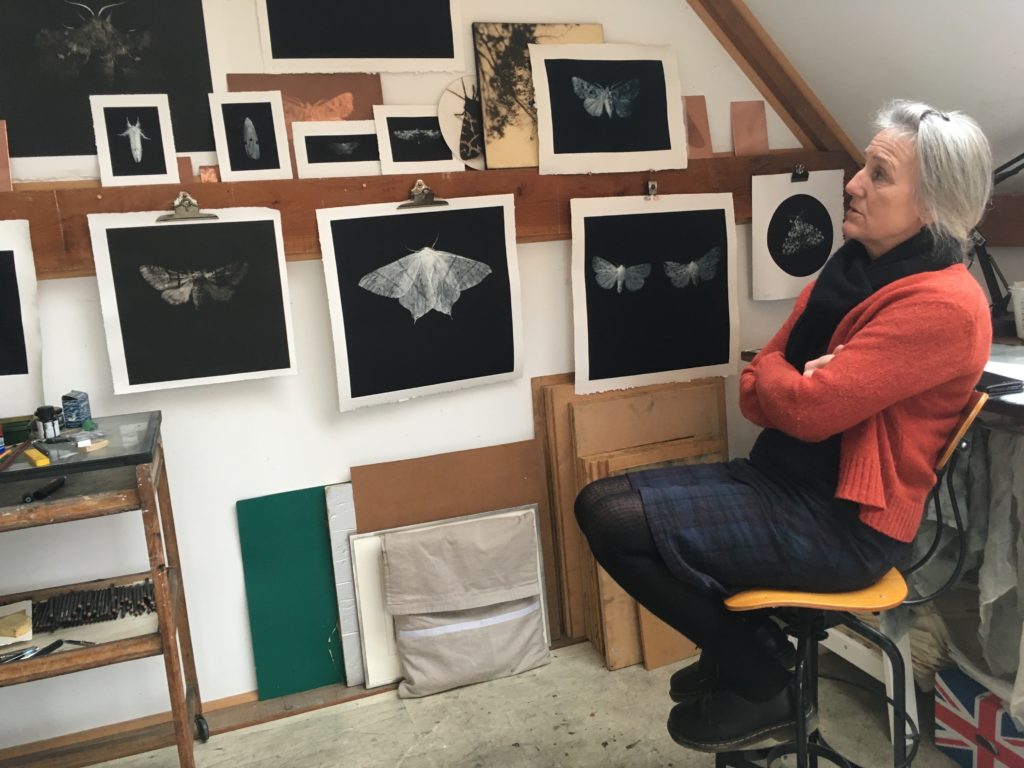
Emerging from the night: a conversation with artist Sarah Gillespie
Luminous, velvety, miraculously detailed, Moths – a series of mezzotints created by artist Sarah Gillespie – invites the viewer to contemplate the mystery of these winged night creatures. Writer Karen Eng chats with Sarah about how moths captured her fascination after a lifetime of painting landscapes, why mezzotint and moths go so well together, and why she wants to call our attention to them.
KE: Tell me something about yourself and your background.
SG: I’m an artist, not an entomologist – nor do I have a background in natural history. But I’ve always lived in the countryside, apart from the years when I was studying. I’ve always walked and I’ve had the habit of solitude, really, so looking at nature is part of my DNA. I don’t even like saying “looking at nature” because it implies a subject-object dualism, which I’m not interested in. I did want to study biology, but I come from the era when they wouldn’t let you do both sciences and arts. You had to choose.
I grew up and went to school in Hampshire, then failed to get into art school. My dad, being an Irish immigrant, said, “Come on, then, let’s let’s go elsewhere. If you want to paint, let’s go to Paris.” He found a little art school in Paris and literally put me in the car with a portfolio and took me for an interview. So I went to Paris for a year and studied 16th- and 17th-century methods and materials with some extraordinary people in an old fashioned atelier. This was unheard of in England. We had a master, worked very long hours, and everybody cooked and helped. We worked and worked. It was a fantastic grounding.
From there, my parents said I had to apply to university, so I ended up at Oxford at the Ruskin School of drawing and fine art. I learned pretty much nothing during three years in the painting school, but I did learn a great deal in the printmaking studios. There I was happier. I found the painting too narcissistic and egotistical, and not sufficiently grounded in technique.
Afterwards I just wanted to start painting. I won quite a large international bursary on leaving Oxford, enough for me to live on for about three years, which was life changing. I haven’t looked back. I’ve been painting and drawing ever since.
My teacher Patrick Betaudier believed that there was nothing wrong with learning techniques – a view that was very unfashionable. That rather than constrain you – which is the current narrative – techniques actually set you free
Sarah Gillespie
KE: Can we go back to the Paris studio? Was it a working studio, and what did they teach there?
It was run by a very interesting man called Patrick Betaudier, a Trinidadian who had come over with a program the English government used to run, where they brought bright kids from the colonies and put them through public schools, then Cambridge, then the RAF as a sort of leadership training. He’d done Cambridge and the RAF, and then after completing postgraduate studies at the Royal College of Art, he decided England was fundamentally racist and he couldn’t stay here any longer. He made his home in Paris after spending time in America, where he was involved in the civil rights movement.
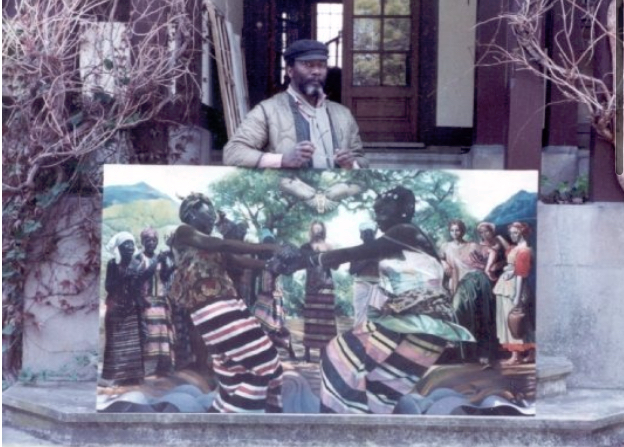
He was just one of these people who really understood the humility, I suppose, of studying things, of bending yourself to them and being prepared to be humble in the face of the great knowledge of those before us. He believed that there was nothing wrong with learning techniques – a view that was very unfashionable. That rather than constrain you – which is the current narrative – techniques actually set you free, especially with painting, because it’s a skill you get better at as you get older. He unashamedly taught technique, method and materials.
It was all painting. Mostly oils – actually technique mixed, which is what Van Eyck used. It has layers of tempera and oil paint, so you layer tempera into wet resin while painting, trapping the pigment between layers of varnish. It’s why, when you look at Van Eycks, they’re so perfect and beautiful. After I left art school, I had a whole career as a landscape painter, selling from Mayfair galleries in London into private collections.
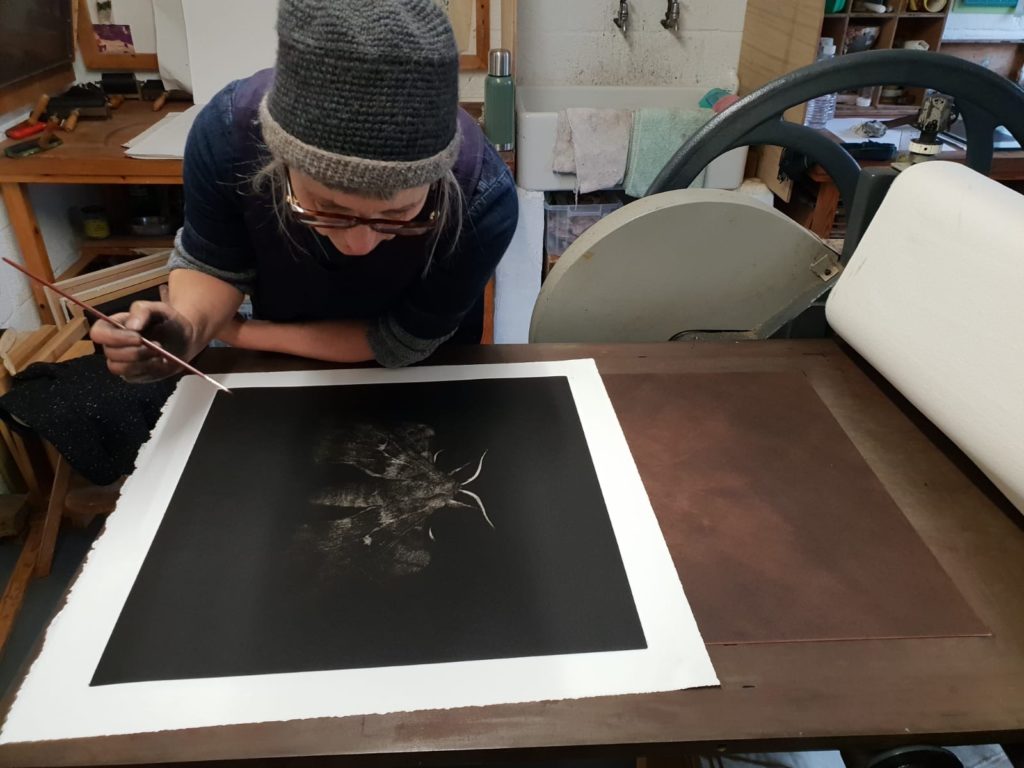
KE: How did you go from being a devoted painter to making moth mezzotints?
SG: About ten years ago, I got a bit creatively blocked, and somebody said, “Come printmaking.” I was reminded how wonderful printmaking is and very slowly started doing a little bit of it on the side. My interest in insects arrived at the same time – the moths started occurring to me artistically.
Meanwhile, this time last year, Extinction Rebellion started happening big time. My sister was very involved, but I don’t deal well with crowds. Plus the poet Mary Oliver has this wonderful line about art requiring a loyalty – the same loyalty that water has to gravity. This is my path. This is what I do. So I started to distance myself a little bit from the whole Mayfair arts scene and open up the question, what can I do for the planet? When I opened up, the moths came pressing in. It was relevant to the movement because these creatures are in steady decline, which I had noticed just from my own observations. Now I was learning the extent of that decline and the knock-on effect on birds and bats.
It became clear that what I needed to do was devote at least a year to making this work. I made an internal vow to talk openly about what I was doing to anybody and everybody who asked me about it – which turned out to be very easy because it’s an awful lot easier for me to talk about matters of urgent conservation than to talk about self-expression. Every time anybody asked me what I was doing, I’d say, “Well, I’ve just been making an engraving of a garden tiger moth. And did you know that they’ve declined 80% due to pesticides, and that’s why you’re not hearing cuckoos anymore?” I would have this conversation repeatedly.
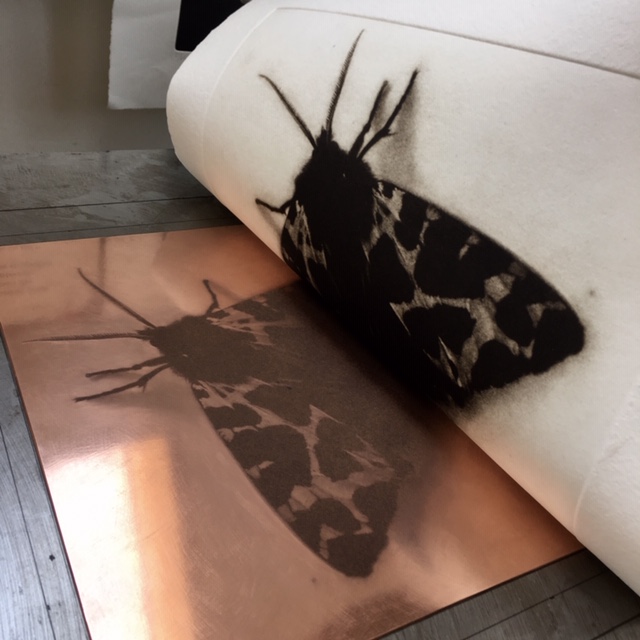
The more I got into it, the more self propelling it became. I think it’s a bit high-flown to say that the conversation has become as much a part of the practice as making the work itself, but it was an important personal commitment. Once I got going – and I was fluent enough with the mezzotint by then for it to take off quite quickly – I couldn’t stop.
My London representation worried about the moths appearing. Neither insects nor prints are exactly popular choices in Mayfair galleries. But the moths were pretty insistent. And with the encouragement of Veronica Sekules, director of GroundWork gallery, they finally found a home in the Bugs: beauty and danger exhibition.
The poplar hawk moth is like a little mouse. It’s extraordinary, a beautiful gray moth that doesn’t have a mouth. It only eats during the caterpillar stage. It’s an entirely winged emanation.
Sarah Gillespie
KE How do you manage to get so close to the moths that you portray?
SG I trap moths in my garden with a very simple lightbox. They often come into the house, and they’re against the windows at night. I’m not a committed entomologist – so I don’t travel to Spain to get rare specimens or anything. I don’t even like putting the trap out two nights in a row in case I catch the same one twice.
I go down very, very early in the morning before the birds can get to them in the summer, and I turn the light off and open up the trap. The smaller ones – the tiny ones – all fly off straight away. They’re very flighty. The bigger ones are not. They sit around on my desk all day. I look at them, photograph them, draw them, and release them. Once you start looking at and gently handling moths, you fall in love a bit. You realize that this is a living creature, and it has its life and its lifecycle.
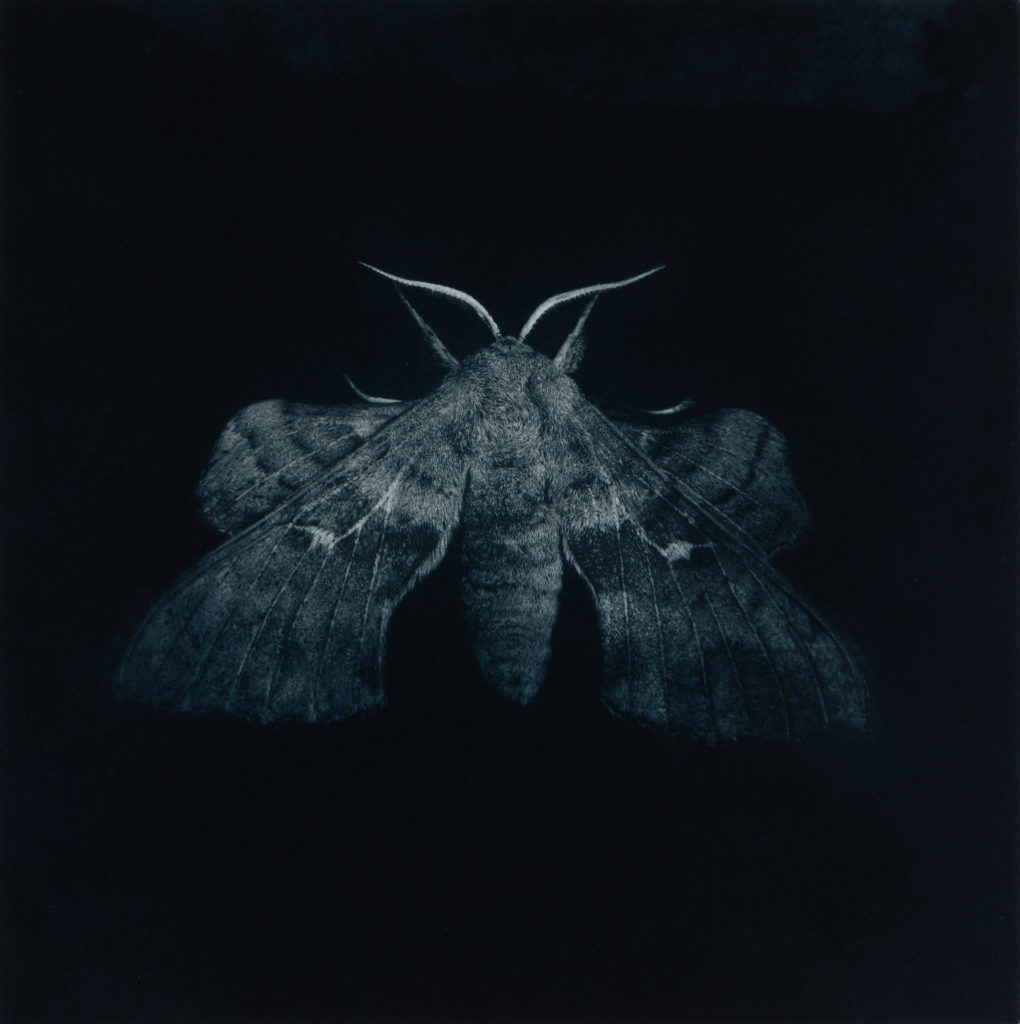
https://www.groundworkgallery.com/product/sarah-gillespie-poplar-hawkmoth-blue-mezzotint-2019/
There’s one called a poplar hawk moth, which is like a little mouse. It’s extraordinary, a beautiful grey moth that doesn’t have a mouth. It only eats during the caterpillar stage. During the winged part of its life cycle, all it needs to do is reproduce. It’s all about flying and having sex. “I fly and have sex and look great as well. Occasionally I might sit around on an artist’s desk….”
KE: How long does it live, once it’s flying, if it only exists to reproduce?
SG: A couple of weeks. Not much longer than that. That’s why I don’t put the trap out two nights in a row. I’ve got a smallish garden, and I figure if I’ve got the same moth twice it’ll be spending two important nights when it needs to be out reproducing stuck in my trap.
What’s interesting to me is the degree to which they’re completely entangled in the fabric of life. They have this four-part lifecycle that’s so dependent on very specific plants, very specific timings. Whole loads of birds time their arrival with the hatching of certain caterpillars, for example. Some relationships are more general. Some will go for all broadleaf trees, and so on, while others are incredibly specific. So cuckoos will only eat woolly bear caterpillars, for instance. It’s more the fact that moths don’t exist separately from the plants, and from the weather, and so on and so forth.
That seemed to me to be a rather wonderful metaphor for the way of things, for the non-separateness of things.
I didn’t choose the moths. You could say they chose me, or they arrived. What you want to work on sort of presses itself in on you, doesn’t it?
Sarah Gillespie
KE: Since you were trained by Patrick Betaudier to value technique so highly, how were you taught to choose your artistic subjects? What’s the mental process that goes on behind how you choose to create work?
SG: That’s a very interesting, good question. I don’t think I’ve ever been asked that before. Patrick didn’t even tackle that. It was almost irrelevant. His attitude was, just paint what moves your heart. For me it was always landscapes. I don’t even think of it as landscapes anymore, just trees.
And I just want to reiterate that I didn’t choose the moths. You could say they chose me, or they arrived. What you want to work on sort of presses itself in on you, doesn’t it? It needs to be held and then responded to in some way. That’s the best way I can put it. I’m very interested in the early Renaissance Annunciation paintings. Are you familiar with them? Those classic images where you have Gabriel announcing the coming of Jesus to Mary. Art is not so different to that. They used to call it a muse, or in Spanish it’s duende. After that, it’s how you respond, what you make of it. First you wait and then you work.
I happened to be developing the mezzotint as a technique and the moths came – and the two were perfect for each other. Mezzotint a method where you draw things out, or things reveal themselves. It’s never quite clear who’s revealing and who’s doing the drawing. And that seemed perfect for the moths, the way they come out of the night.
KE: Tell me about the process of how you make your mezzotints. They look incredibly deep and textured, and almost like you’ve actually printed a moth onto the paper.
SG: Mezzotint was invented in the 17 century as an extension of copperplate engraving – the main method for reproducing oil paintings.
You take a piece of copper plate, and you roughen the surface with a curved serrated blade that looks like an herb chopper. If you rock this across a shiny piece of copper in 64 different directions, the entire surface of the copper becomes roughened. You then take scrapers and burners – steel tools – and scrape the roughness off, working back towards the smooth shiny copper.
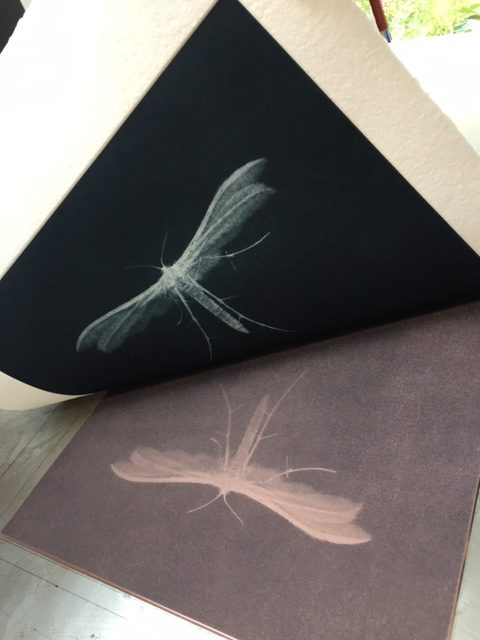
You apply sticky printer’s ink to the plate, which stays in all the pits and grooves. This prints the most extraordinary velvety black. Where the copper is smooth and shiny, it prints white, because all the ink wipes off the surface. Then obviously there’s every tone in between. If you just scrape a little bit, you get a dark gray, and so on – these incredible soft gradations. You draw the image as a mirror of the final print, as with all printing, and you’re working from dark to light.
KE: How do you translate the incredible detail of the moths with a technique like that?
SG: I’m hoping it’s going to stop me getting dementia. Once you get into it, you start to know what tone you’ll get by listening to the sound of the scrapers on the copper. There’s a big difference between the prints I made at the beginning of the year and my more recent ones. I got much more fluent with it.
Mezzotint is all about tone, which is how we typically perceive moths because they are in constant motion
Sarah Gillespie
KE: I can see now why you’d say this technique is perfect for moths because they do literally emerge into the light from the darkness.
SG: Yes, and its velvety texture. I love mezzotint for its softness and blurriness. There’s no line involved at all. It’s all about tone, which is how we typically perceive moths because they are in constant motion. Normally when we see them against the window, they’re fluttering. So the only time we see them very clearly is when they’re pinned in a Victorian collection.
If you have a moth on your desk, when it decides it’s had enough of sitting there, it has to get its body temperature to 30 degrees in order to fly. So it will move its muscles as a way of warming up – it vibrates.
The more I realized that people are frightened of them…the more it became clear that it’s exactly the job of artists to point out the beauty in things that are unloved.
Sarah Gillespie
KE: Why do you think moths were pressing at you – and not anything else? You could have become obsessed with butterflies or frogs or ladybirds or anything. Lots of creatures are in decline.
SG: I don’t know. It was really strange. It wasn’t a bolt of thunder or anything, but the more I
followed it, the more it became apparent that this was right. Doors kept opening, and things kept happening. Very early on, the poet Alice Oswald saw the mezzotints and sent me a poem that she’d written about a moth. I’ve made a limited edition book, too, because Alice and I have a mutual friend who is a wonderful book designer.
I think there’s something about the way moths come out of the night, and the fact that we don’t know very much about them. The more I realized that people are frightened of them – women in particular think they’re going to land in their hair – the more it became clear that it’s exactly the job of artists to point out the beauty in things that are unloved.
There’s something in the fact that the caterpillar has to die to itself to become a moth that flies. There’s something rather extraordinary about that.
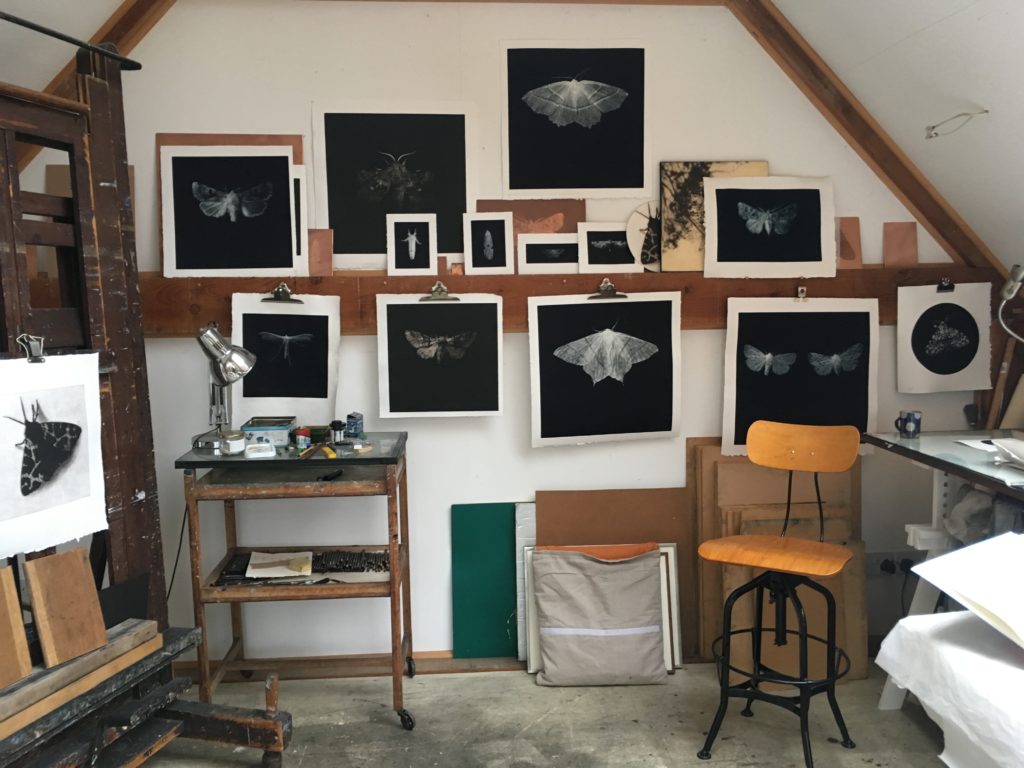
Endnote
Sarah Gillespie is a committed environmentalist, keen for her work to raise awareness of the intricacy and beauty of the natural world and to address our troubled relationships with insects in more positive ways. Trained as an artist at the Ruskin School of Drawing, Oxford, and in Paris in historical painting methods from 16th and 17th century. Sarah is known for her close observation, attention to detail and finish, and the perfectionism of her contemporary interpretations of traditional methods. She has exhibited widely in the UK and is an Academician with the Royal West of England Academy. https://www.sarahgillespie.co.uk/

